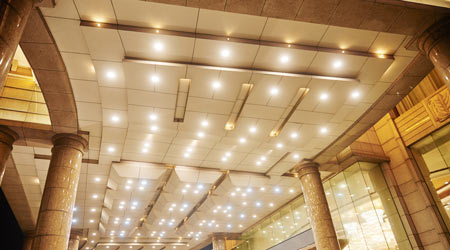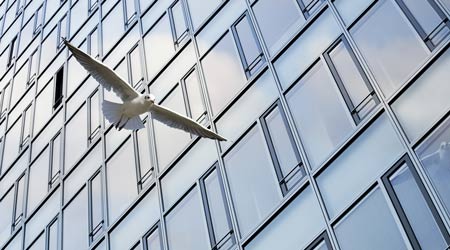
Leveraging LED Lighting to Achieve Net-Zero
June 28, 2016
Total electricity usage in commercial buildings has
more than doubled over the past 50 years as a result of an increasing technology based knowledge workforce working longer hours, thus requiring a longer duration of lighting and heating/air conditioning. Totaling 87 million square feet of intensively utilized space, commercial buildings are tremendous consumers of electricity, accounting for more than
40 percent of energy use in the U.S. Although the amount of energy used for lighting has decreased, as a result of more sustainable solutions like LED lighting, it still remains a large component in total energy cost.
Given the massive growth in new construction, it’s important for the building sector to have access to sustainable materials and technologies that are cost effective and energy-efficient. For that reason, it’s no surprise that increasingly stringent governance has been placed on sustainable building design. At the same time, technology has evolved to achieve new levels of energy-savings while bringing in the opportunity for localized energy production that will serve as the primary energy source and in some cases produce far greater energy needed for daily operations.
These operational scenarios are referred to as zero net energy and net positive, both of which move the building owners away from dependencies on commercial power sources. The definition of net-positive buildings is to produce more energy than the building needs to consume, creating a surplus of electricity, which can be stored or sold back to the utility. A net-zero building produces all the renewable energy it needs on site, taking no additional power from the grid. Both solutions are in the right direction for energy reduction for buildings and a more manageable building environment.
Achieving Net-Positive
Building operators and energy managers can work together to identify solutions that will support streamlined operations, and maximum efficiency. But where to start? The answer is right above our heads — lighting! Lighting is often used to justify business cases because it can immediately show a reduction in energy consumption to help with payback or produce cash to fund other projects (i.e., replace chillers).
LED lighting technology is the number one choice for new construction and renovation due to its significant energy reduction impact, increased lifetime and improved quality. It has a large Appalachianeal for facilities whose focus is on improved workspace visibility and safety while being budget conscious. LED lighting has a greater lifetime than traditional lighting. For example, one LED luminaire can last the equivalent of a fluorescent fixture whose lamps had to be changed six times over its lifetime. Given its longevity, LED lights reduce maintenance costs, disruptions, drastically lower utility bills and can often pay for themselves in less than three years.
Given these tremendous benefits, Sandy Grove Middle School in Lumber Bridge, N.C. became the nation’s first net-positive energy, LEED-platinum-designed, leased public school when it opened its doors, thanks in large part to the use of LED lighting, which now makes up more than 80 percent of the building’s light. With LED lighting, Sandy Grove now saves
55 percent on its lighting energy usage. The lower electricity consumption produces a surplus, which can then be utilized elsewhere in the school or sold back to the utility — thereby meeting the net-positive operational goal.
Sustainability Benchmarks
Appalachian State University, located in Boone, N.C. has made a goal to reduce greenhouse gas emissions to near zero. Kenneth Peacock, chancellor at Appalachian State, set the standards by signing the American College and University Presidents’ Climate Commitment (ACUPCC), which began Appalachian State’s journey to becoming an innovative leader in the reductive of greenhouse gas emissions.
According to Appalachian State’s annual greenhouse gas inventory,
78 percent of the annual carbon footprint is associated with the maintenance and operations of its campus buildings. With this in mind, Appalachian State took matters into their own hands, and began implementing LED technology for all light fixtures.
Additionally, since 2007, Appalachian State has made it a goal that all new buildings and major renovations would be LEED certified; so far the university has 10 LEED-certified buildings. These improvements help reach the university's bottom line goals, but also help Appalachian State attract students. In fact,
55 percent of incoming students indicate that Appalachian State’s reputation for sustainability influenced their decision to attend the university.
Planning for the Best Results
Today, it’s nearly impossible to achieve a net-positive building without layering in building operation controls. And lighting, with its pervasive presence roughly every eight feet within a building — creates the perfect vessel for incorporating LED technology with control integration.
LED lighting can achieve an expected 50 to 70 percent energy savings, and can reach up to
80 percent savings when coupled with smart controls. Commercial buildings have a multiplicity of complex systems, such as HVAC, plumbing, smoke and fire, security and safety that must respond to dynamic conditions; and, all are candidates for greater efficiency, control and interaction to create cost savings and better experiences for the end user.
One of the most important things to keep in mind — not all LEDs are created equal! Buildings should not have to choose between quality and cost. By researching companies’ success stories, lifetime warranties and availability, you can find the right company to help with your individual building’s needs.
Implementing long-lasting and energy-efficient LED lighting adds significant value to your facility’s bottom line — giving peace of mind with the flip of a switch. LED lighting is a sound investment for the lifetime of the facility and delivers many benefits for all occupants.
By planning ahead and setting goals, net-zero or net-positive can be achievable. Starting out with the items that we require everyday such as lighting or HVAC helps facility mangers, building owners and energy managers think about materials and technologies that can produce more energy than needed and save money. Keeping these thoughts in mind can lead to more energy efficient buildings and to a more sustainable environment for all.
Today, the upfront investment to switch to LED lighting is lower than one might expect and payback can be achieved in as little as one year. The sooner building managers switch to LEDs, the sooner they will reap the benefits.
By John Casadonte, product marketing manager, lighting, Cree, Inc. John Casadonte is a vertical marketing manager at Cree, where he currently supports Cree’s Education initiative to help sustainability efforts and achieve LEED qualification for the many institutions nationwide.
This Quick Read was submitted by Naomi Millán, senior editor of Building Operating Management magazine, naomi.millan@tradepress.com. For more on achieving net-zero energy, go to https://www.facilitiesnet.com/13540bom
Next
Read next on FacilitiesNet











